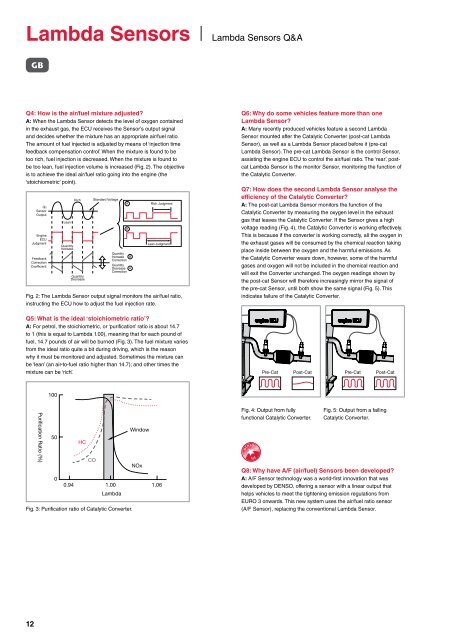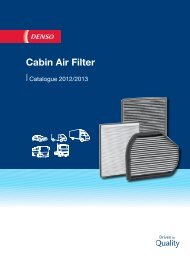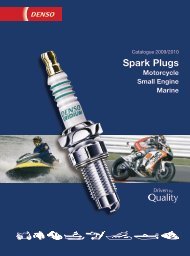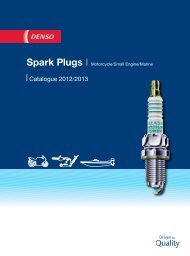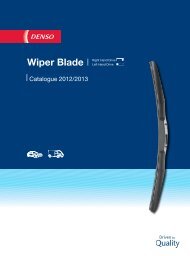Create successful ePaper yourself
Turn your PDF publications into a flip-book with our unique Google optimized e-Paper software.
<strong>L<strong>am</strong>bda</strong> <strong>Sensors</strong> <strong>L<strong>am</strong>bda</strong> <strong>Sensors</strong> Q&A<br />
12<br />
GB<br />
Q4: How is the air/fuel mixture adjusted?<br />
A: When the <strong>L<strong>am</strong>bda</strong> Sensor detects the level of oxygen contained<br />
in the exhaust gas, the ECU receives the Sensor’s output signal<br />
and decides whether the mixture has an appropriate air/fuel ratio.<br />
The <strong>am</strong>ount of fuel injected is adjusted by means of ‘injection time<br />
feedback compensation control’. When the mixture is found to be<br />
too rich, fuel injection is decreased. When the mixture is found to<br />
be too lean, fuel injection volume is increased (Fig. 2). The objective<br />
is to achieve the ideal air/fuel ratio going into the engine (the<br />
‘stoichiometric’ point).<br />
Fig. 2: The <strong>L<strong>am</strong>bda</strong> Sensor output signal monitors the air/fuel ratio,<br />
instructing the ECU how to adjust the fuel injection rate.<br />
Q5: What is the ideal ‘stoichiometric ratio’?<br />
A: For petrol, the stoichiometric, or ‘purification’ ratio is about 14.7<br />
to 1 (this is equal to <strong>L<strong>am</strong>bda</strong> 1.00), meaning that for each pound of<br />
fuel, 14.7 pounds of air will be burned (Fig. 3). The fuel mixture varies<br />
from the ideal ratio quite a bit during driving, which is the reason<br />
why it must be monitored and adjusted. Sometimes the mixture can<br />
be ‘lean’ (an air-to-fuel ratio higher than 14.7); and other times the<br />
mixture can be ‘rich’.<br />
Fig. 3: Purification ratio of Catalytic Converter.<br />
Q6: Why do some vehicles feature more than one<br />
<strong>L<strong>am</strong>bda</strong> Sensor?<br />
A: Many recently produced vehicles feature a second <strong>L<strong>am</strong>bda</strong><br />
Sensor mounted after the Catalytic Converter (post-cat <strong>L<strong>am</strong>bda</strong><br />
Sensor), as well as a <strong>L<strong>am</strong>bda</strong> Sensor placed before it (pre-cat<br />
<strong>L<strong>am</strong>bda</strong> Sensor). The pre-cat <strong>L<strong>am</strong>bda</strong> Sensor is the control Sensor,<br />
assisting the engine ECU to control the air/fuel ratio. The ‘rear’, post-<br />
cat <strong>L<strong>am</strong>bda</strong> Sensor is the monitor Sensor, monitoring the function of<br />
the Catalytic Converter.<br />
Q7: How does the second <strong>L<strong>am</strong>bda</strong> Sensor analyse the<br />
efficiency of the Catalytic Converter?<br />
A: The post-cat <strong>L<strong>am</strong>bda</strong> Sensor monitors the function of the<br />
Catalytic Converter by measuring the oxygen level in the exhaust<br />
gas that leaves the Catalytic Converter. If the Sensor gives a high<br />
voltage reading (Fig. 4), the Catalytic Converter is working effectively.<br />
This is because if the converter is working correctly, all the oxygen in<br />
the exhaust gases will be consumed by the chemical reaction taking<br />
place inside between the oxygen and the harmful emissions. As<br />
the Catalytic Converter wears down, however, some of the harmful<br />
gases and oxygen will not be included in the chemical reaction and<br />
will exit the Converter unchanged. The oxygen readings shown by<br />
the post-cat Sensor will therefore increasingly mirror the signal of<br />
the pre-cat Sensor, until both show the s<strong>am</strong>e signal (Fig. 5). This<br />
indicates failure of the Catalytic Converter.<br />
Fig. 4: Output from fully Fig. 5: Output from a failing<br />
functional Catalytic Converter. Catalytic Converter.<br />
DENSO<br />
1st<br />
Q8: Why have A/F (air/fuel) <strong>Sensors</strong> been developed?<br />
A: A/F Sensor technology was a world-first innovation that was<br />
developed by DENSO, offering a sensor with a linear output that<br />
helps vehicles to meet the tightening emission regulations from<br />
EURO 3 onwards. This new system uses the air/fuel ratio sensor<br />
(A/F Sensor), replacing the conventional <strong>L<strong>am</strong>bda</strong> Sensor.


